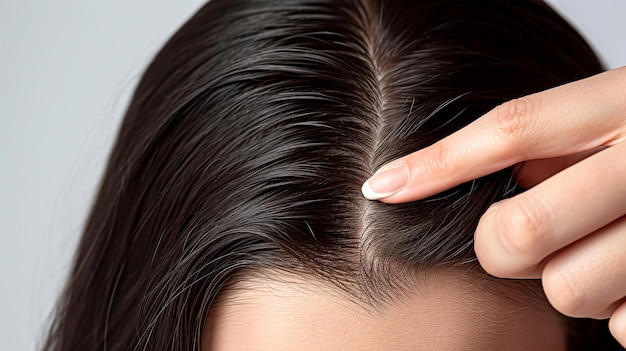Protecting Black Women's Health: Examining The Risks Of Synthetic Hair Braids

Table of Contents
Traction Alopecia and Hair Loss from Synthetic Braids
Understanding Traction Alopecia
Traction alopecia is a form of hair loss caused by prolonged pulling or tension on the hair follicles. With synthetic hair braids, particularly those that are tightly braided, this constant tension becomes a major contributing factor. The consistent pulling weakens the hair follicles, leading to inflammation and, ultimately, hair loss.
- Tight braids: The most significant cause, placing immense stress on hair follicles.
- Weakened follicles: Continuous tension leads to thinning and damage over time.
- Miniaturization: Hair follicles shrink, potentially resulting in permanent hair loss.
- Frequency and duration: Women who frequently wear tight braids for extended periods are at increased risk.
Studies show a high prevalence of traction alopecia among Black women who regularly wear tight braids and other protective styles. The good news is that early detection and prevention are key; however, regrowth can be challenging once significant hair loss has occurred.
Scalp Infections and Irritation from Synthetic Hair Braids
Bacteria and Fungi Growth
Synthetic hair braids, especially when not properly maintained, can create a breeding ground for bacteria and fungi. The weave traps sweat, dirt, and oils close to the scalp, providing a warm, moist environment ideal for microbial growth.
- Sweat and oil trapping: Synthetic braids prevent proper ventilation, leading to buildup.
- Bacterial and fungal growth: This buildup creates a prime environment for infections.
- Common infections: Folliculitis, tinea capitis (ringworm), and other scalp infections can occur.
- Hygiene is crucial: Regular cleaning and maintenance are vital in preventing these issues.
Symptoms of scalp infections can include itching, redness, inflammation, and even pus-filled bumps. Regular scalp cleansing with an appropriate anti-fungal shampoo, like those containing ketoconazole or selenium sulfide, can significantly reduce the risk. If you notice any signs of infection, consult a dermatologist or healthcare professional immediately.
Chemical Exposure and Allergic Reactions from Synthetic Hair Braids
Harmful Chemicals in Synthetic Hair
Many synthetic hair extensions contain formaldehyde and other harsh chemicals used in the manufacturing process. These chemicals can irritate the scalp and trigger allergic reactions in sensitive individuals.
- Formaldehyde and other chemicals: Common additives in synthetic hair fibers.
- Scalp irritation and allergies: These chemicals can cause itching, inflammation, and contact dermatitis.
- Severity of reactions: Symptoms range from mild itching to severe inflammation and skin reactions.
- Choosing safer options: Selecting high-quality synthetic hair with minimal chemical additives is crucial.
Always carefully examine product labels, searching for certifications and indications of lower chemical content. Prolonged exposure to these harsh chemicals can have long-term consequences on scalp health and overall well-being.
Best Practices for Minimizing Risks Associated with Synthetic Hair Braids
Choosing the Right Stylist and Hair
Minimizing the risks associated with synthetic hair braids requires careful consideration of both the stylist and the hair extensions themselves.
- Experienced stylist: Choose a professional experienced in braiding and protective styling techniques.
- High-quality extensions: Opt for breathable synthetic hair with minimal added chemicals. Look for brands with a reputation for quality.
- Avoid excessively tight braiding: Properly installed braids should not cause pulling or discomfort.
- Maintain scalp hygiene: Regularly cleanse your scalp and hair to remove dirt and oil buildup.
- Take breaks: Give your scalp and hair a break from braids periodically to allow for proper healing and growth.
Regularly moisturizing your scalp with natural oils and incorporating gentle scalp treatments can also significantly improve your scalp's health and resilience. Consider removing your braids every 6-8 weeks, allowing your scalp and hair to breathe and recover.
Conclusion
While synthetic hair braids offer a stylish and convenient option, understanding the potential risks is paramount for protecting your health. By being aware of the potential for traction alopecia, scalp infections, and chemical exposure, and by taking proactive steps – like choosing experienced stylists, high-quality, low-chemical extensions, and maintaining excellent scalp hygiene – Black women can significantly minimize the risks associated with synthetic hair braids. Remember to prioritize your health when choosing and maintaining your synthetic hair braids, and consult a healthcare professional if you experience any concerning symptoms. Prioritize your well-being and make informed choices regarding your synthetic hair braid journey.

Featured Posts
-
 Zamach Na Roberta F Kennedyego Odtajnione Dokumenty Rzucaja Nowe Swiatlo Na Sprawe
May 27, 2025
Zamach Na Roberta F Kennedyego Odtajnione Dokumenty Rzucaja Nowe Swiatlo Na Sprawe
May 27, 2025 -
 Chomu Putin Prodovzhuye Viynu V Ukrayini Analiz Politichnoyi Situatsiyi
May 27, 2025
Chomu Putin Prodovzhuye Viynu V Ukrayini Analiz Politichnoyi Situatsiyi
May 27, 2025 -
 The New Gucci Exhibition A Shanghai Highlight
May 27, 2025
The New Gucci Exhibition A Shanghai Highlight
May 27, 2025 -
 Security Forces Eliminate Top Bandit In Zamfara Following Attack
May 27, 2025
Security Forces Eliminate Top Bandit In Zamfara Following Attack
May 27, 2025 -
 Gucci Spring Sale 70 Off Designer Handbags Sneakers Hats And Sunglasses At Gilt
May 27, 2025
Gucci Spring Sale 70 Off Designer Handbags Sneakers Hats And Sunglasses At Gilt
May 27, 2025
Latest Posts
-
 Bts 2025 Informations Sur Les Dates D Examens Et De Resultats
May 30, 2025
Bts 2025 Informations Sur Les Dates D Examens Et De Resultats
May 30, 2025 -
 Dates Bts 2025 Examens Et Annonce Des Resultats
May 30, 2025
Dates Bts 2025 Examens Et Annonce Des Resultats
May 30, 2025 -
 Calendrier Bts 2025 Epreuves Et Resultats
May 30, 2025
Calendrier Bts 2025 Epreuves Et Resultats
May 30, 2025 -
 Bts Drops Reunion Teaser Sparks Intense Comeback Debate
May 30, 2025
Bts Drops Reunion Teaser Sparks Intense Comeback Debate
May 30, 2025 -
 Update On Bts Ceo Addresses Comeback Timeline And Member Needs
May 30, 2025
Update On Bts Ceo Addresses Comeback Timeline And Member Needs
May 30, 2025
